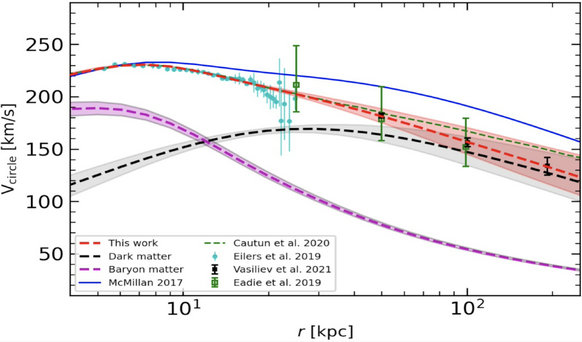Astronomers reveal a light Milky Way from Gaia EDR3 data
The Milky Way mass is one fundamental quantity in modern astrophysics and cosmology, which has direct impact on many astrophysical problems. With high precision data from GAIA EDR3 combined with new generation dynamical modeling method, an international research team has measured the Milky Way total mass. They found the Milky Way mass is ranged from five to eight thousand billion solar mass, which indicates a smaller Galactic mass with respect to previous measurements.
The research result, led by Chinese astronomer Jianling WANG at National Astronomical Observatories of Chinese Academy of Sciences (NAOC) with collaboration with Francois Hammer and Yanbin Yang from Paris observatory under the framework of Sino-French collaboration project "Tianguan", has been published on Monthly Notices of the Royal Astronomical Society.
Previous studies for Galactic dynamics were affected by two aspects, either they were based on too small data set that introduced large uncertainties, or the tracers they used were lacking information. The later could be serious since simple hypothesis on equilibrium of some distant tracers have been taken introducing unknown systematic problem.
Now we are entering a gold era in Galactic archeology with the progress of large scale spectroscopic survey and high precision proper motion measurements from the Gaia satellite, providing a huge amount of high quality data. This overcomes many difficulties mentioned above, especially by providing a full six-dimensional information for high precision tracers acquired with GAIA.
Using these unprecedented data to study how our Milky Way and its halo are structured and how they assembled together is the central task lying before astronomers. Dynamic modeling is the central tool for this task.
The astronomers have used a new generation analytical dynamic modeling technique, which is the action-based distribution function dynamical modeling. They derived the Milky Way baryon mass and dark matter mass distribution function, which in turn provide accurate Milky Way total mass.
Thanks to the Gaia precise proper motions, they derived the most precise kinematic information for around 150 Galactic globular clusters. With the MCMC method, they combined this information with the accurate rotation curve information from disk region also based on Gaia data. The flexible action-based distribution function overcomes many simplistic assumptions adopted by previous studies, which leads to a more realistic distribution function of the tracers, and to a Milky Way mass distribution function.
N-body simulation and realistic cosmological hydrodynamic simulations have been used in this work to quantify any systematics introduced by the Large Magellanic Cloud passing by and unrelaxed substructures.
They found that the Galactic total mass are ranged from five to eight hundred billion solar mass, which indicate a light Milky Way when comparing to previous measurements. This new measurement has many implications for cosmological problem and Milky Way satellite origins.

Figure: Comparing the Galactic rotation curve with literatures. The dark and magenta dashed lines indicate the rotation curves from dark matter and baryonic matter. (Credited: Wang et al. 2022)
The research paper is available at https://academic.oup.com/mnras/article/510/2/2242/6424955